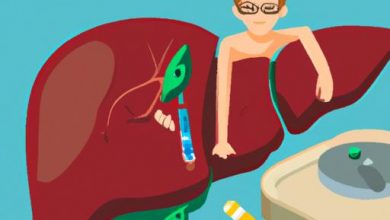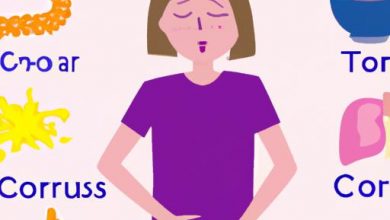What is Celiac Disease: Causes, Symptoms, Diagnosis, Treatment, Complications, and Prevention
Introduction

Celiac disease is a chronic autoimmune disorder that affects the small intestine’s lining and prevents it from absorbing nutrients from food. It is triggered by the ingestion of gluten, a protein found in wheat, rye, and barley. In this article, we will explore the causes, symptoms, diagnosis, treatment, complications, and prevention of celiac disease.
Causes and Risk Factors
Celiac disease is caused by a combination of genetic and environmental factors. If you have a family member with celiac disease, you are more likely to develop the condition. Environmental factors such as a viral infection or a stressful event can trigger the onset of celiac disease in genetically predisposed individuals. Other medical conditions such as type-1 diabetes, autoimmune thyroid disease, and Down syndrome increase the risk of developing celiac disease.
Symptoms of celiac disease can vary from person to person and can range from mild to severe. Some people may not experience any symptoms at all. The most common symptoms of celiac disease are related to the digestive system, including abdominal pain, bloating, diarrhea, and constipation. However, celiac disease can also cause non-digestive symptoms such as anemia, fatigue, joint pain, and skin rashes.
Conclusion
Celiac disease is a chronic autoimmune disorder that affects the small intestine’s lining, preventing it from absorbing nutrients from food. It is caused by a combination of genetic and environmental factors and can lead to a range of symptoms, from mild to severe. In the next section, we will discuss in detail how celiac disease is diagnosed and the various diagnostic methods used.
Symptoms
Celiac disease can cause a range of symptoms, which can be broadly classified into digestive and non-digestive symptoms. Digestive symptoms are more common and can include abdominal pain, bloating, diarrhea, constipation, and nausea. Non-digestive symptoms can include anemia, fatigue, joint pain, skin rashes, mouth ulcers, and headaches. Some people with celiac disease may also experience neurological symptoms such as depression, anxiety, and peripheral neuropathy. The severity of symptoms can vary widely between individuals, and some people may not experience any symptoms at all.
Diagnosis
Diagnosing celiac disease can be challenging, as the symptoms can be similar to other digestive disorders. The first step in diagnosing celiac disease is a blood test to check for the presence of certain antibodies in the blood. If the blood test is positive, a biopsy of the small intestine is usually performed to confirm the diagnosis. During the biopsy, a small sample of tissue is taken from the small intestine and examined under a microscope for signs of damage to the intestinal lining. Other diagnostic methods, such as genetic testing, may also be used to confirm a diagnosis of celiac disease.
It is essential to diagnose celiac disease early, as untreated celiac disease can lead to long-term complications such as osteoporosis, infertility, and an increased risk of certain types of cancer. If you suspect you may have celiac disease, it is important to speak to your healthcare provider, who can perform the necessary tests and refer you to a gastroenterologist if necessary.
Conclusion
Celiac disease can be challenging to diagnose as symptoms can be similar to other digestive disorders. However, a blood test and biopsy of the small intestine are usually used to confirm the diagnosis. Early diagnosis is crucial to prevent long-term complications, so if you suspect you may have celiac disease, speak to your healthcare provider. In the next section, we will discuss the various treatment options available for celiac disease, including the gluten-free diet and medications.
Treatment
The only treatment for celiac disease is a strict gluten-free diet. This means avoiding all foods that contain wheat, rye, barley, and any derivatives of these grains. Even small amounts of gluten can cause damage to the small intestine in individuals with celiac disease. A gluten-free diet can be challenging, but it is essential for managing the condition and preventing complications. It is important to work with a registered dietitian to ensure a balanced and nutritious diet.
In some cases, medications may be prescribed to manage the symptoms of celiac disease. For example, anti-inflammatory drugs may be used to reduce intestinal inflammation, and corticosteroids may be used to reduce inflammation in other parts of the body. Nutritional supplements may also be recommended to address any nutrient deficiencies caused by malabsorption.
Complications and Prevention
Untreated celiac disease can lead to a range of complications, including osteoporosis, anemia, infertility, and an increased risk of certain cancers. It is important to seek early diagnosis and treatment to prevent these complications. Individuals with celiac disease should also be screened regularly for associated conditions such as type-1 diabetes and thyroid disease.
The best prevention strategy for celiac disease is to maintain a gluten-free diet if you have the condition or have a family history of celiac disease. If you suspect you may have celiac disease, it is important to talk to your healthcare provider and get tested. Early diagnosis and treatment can prevent complications and improve overall health and quality of life.
Conclusion
Celiac disease is a chronic autoimmune disorder that requires a strict gluten-free diet as the only treatment. Medications and nutritional supplements may also be used to manage symptoms and address nutrient deficiencies caused by malabsorption. Untreated celiac disease can lead to a range of complications, but early diagnosis and treatment can prevent these complications. Maintaining a gluten-free diet and getting regular screenings for associated conditions are the best prevention strategies for celiac disease.




